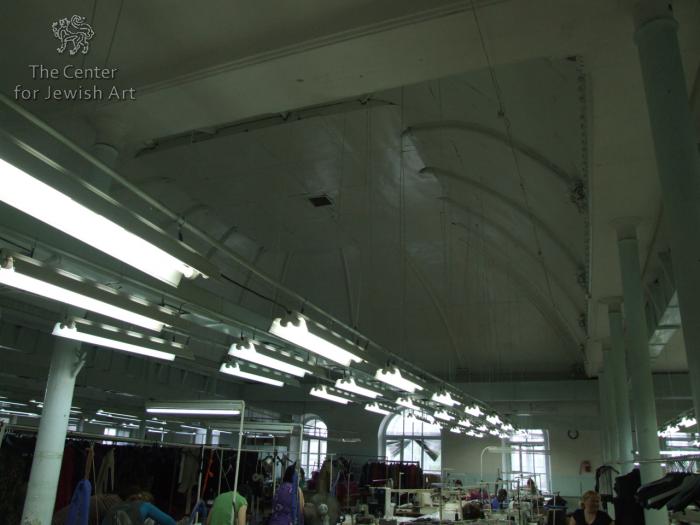Obj. ID: 14982 Great Synagogue in Kovel - interior, photos of 2011

Steel ribs divide the vault into 16 segments, five on its southern and northern sides, and three on the western and eastern sides. According to witnesses’ memoirs, the vault was painted, by “a non-Jewish artist from Odessa,” with depictions of musical instruments, as named in Psalm 150.[1] Presently, tin sheets line the dome vault from underneath, and it is not clear whether the paintings were made on this very tin, or whether they were substituted or covered with a new tin layer.
[1] Yosef Shapiro, “Mi-ma’amakim (zikhroynes vegn unzer heym-shtot kovle),” Pinkos kovel, ed. Bezalel Baler (Buenos Aires, 1951), 180; Eliyahu Mandel, “Kipat beit ha-kneset ha-gadol be-kovel,” Irgun yotsei Kovel be-Israel, Dapei hantsaḥah u-meida 5 (2000): 25. (www.israeli-kovel-org.org/magazines/magazin5.pdf, accessed 14.10.2014). Mandel’s testimony that the vault was divided into six parts seems doubtful and probably originates from the fact that the Psalm contains six verses.
sub-set tree:
Yosef Shapiro, “Mi-ma’amakim (zikhroynes vegn unzer heym-shtot kovle),” Pinkos kovel, ed. Bezalel Baler (Buenos Aires, 1951), 180. Eliyahu Mandel, “Kipat beit ha-kneset ha-gadol be-kovel,” Irgun yotsei Kovel be-Israel, Dapei hantsaḥah u-meida 5 (2000): 25. (www.israeli-kovel-org.org/magazines/magazin5.pdf, accessed 14.10.2014).
Kravtsov, Sergey and Vladimir Levin. Synagogues in Ukraine: Volhynia (Jerusalem: Zalman Shazar Center and the Center for Jewish Art, 2017)

